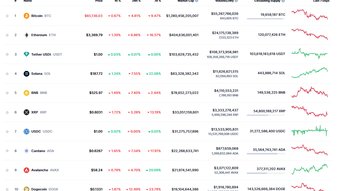Lending Versus Staking – Explained
13
About :
There is so much opportunity in the world of crypto passive income, but there’s also a lot of misconceptions. The biggest one is that lending and staking are interchangeable and offer the same thing. Let’s discuss the differences.
This guide on Coinmarketcap offers the best breakdown on staking that you could possibly find: https://coinmarketcap.com/alexandria/article/crypto-staking-guide-2021
They also offer guides on a lot of useful concepts and topics in crypto.
I’ve seen countless exchanges and heavily centralized institutions offer “staking” which was really lending. Binance & Crypto.com are too widely known examples of this. Even if the platform offers TRUE staking but is an exchange, the benefits and cons are the exact same as lending.
After rigorously going through reddit and various forums, I’ve concluded that most exchanges just misuse the word staking and are simply lending. This is easily understood by contemplating how they for example, you can get make 19.26% from “staking” TUSD on Crypto.com’s DeFi wallet. TUSD is a stablecoin meaning it’s not really changing in value and yet somehow, you can earn nearly 20% on it. The only way this is even possible is from lending it given there are currently no fiat-pegged stablecoins that can natively be staked.
This is plainly seen through three things:
- Users can stake unstakable coins.
- Stablecoins offering returns.
- Returns that are way above what the coin natively offers.
After some digging and help from my community, I found the answer here: https://help.crypto.com/en/articles/4675818-all-about-defi-earn-on-crypto-com-defi-wallet
When you stake ATOM or CRO, you are actually staking. When you “stake” anything else, it’s really just being lent. This includes TUSD and thus proves my initial concern that staking and lending are used interchangeably and I would argue that they purposefully try to make you confuse the two at their benefit.
The biggest differentiation between lending and staking is the control and ownership of the crypto that you are dedicating to the process. With lending, you are required to give up control and thus you do not have full ownership. Typically, you either have to give it to the entity to hold or you hold it on an exchange platform like Blockfi, Crypto.com, Nexo, Celsius, etc. The issue is that you have to KYC and you must ask permission to withdraw your funds. There may also be minimum withdrawals, fees, and much more, but the main caveat is that the responsibility and the liability is no longer yours. If they get hacked, the owner does something malicious, they get sued, go bankrupt, etc., then your crypto is gone too. Soft-staking is what most exchanges offer where it’s not exactly true staking or it’s just lending of some kind.
With staking, you can typically do this from a native wallet for that network or from various DeFi wallets. Staking / decentralized lending can also be done through smart contracts. For example, you can lend on TrueFi through a smart contract, you can stake/lend various coins on Trust Wallet through a smart contract, or you can stake directly through a smart contract on a native wallet using Tron like TronLink.
Outside of exchanges and lending platforms, you should also avoid staking-as-a-service platforms like MyCointainer because they still typically take ownership of your crypto in order to stake it or charge huge fees to use their service.
The main ways I stake currently are through Hive and Tron using their native wallets. On Hive I hold HBD in savings for a 10% APR claimed and compounded monthly while my Hive is delegated to earn approximately 13% APR claimed and compounded daily. Note that you do need to power up your earnings for it to truly compound daily though. I’ve tested the Crypto.com DeFi wallet and it’s good for staking, though your options are limited to mostly ERC20 tokens, so the gas fees make it not really worth using. Essentially using any non-custodial wallet that you control, offer staking or lending via smart contracts, has no KYC, and that you have the keys/seed phrase for should have you covered.
One thing I appreciate a lot about crypto passive income is that it’s easier to compound with payouts being paid out more often, has fewer fees, and you receive your payouts in the crypto making it easier to compound and less effort to manage, typically payouts are higher, and it can be achieved in a fully decentralized way.
A few more notes for staking: there are typically lock-up periods or stakeout times. A lock-up period is how long you have to lock up your coins before withdrawing and a stakeout time is how long it takes to unstake. There may also be minimum requirements to start staking and for claiming staking rewards. These are all important to keep in mind when shopping around for what you may want to stake. Sometimes staking will be a bit more advanced where you have delegated proof of stake and DPoS Witnesses who are essentially people that rune the nodes. An example of this is Hive, where you can earn your 3% on your staked Hive or you can delegate it using Dlease.io as an example and earn an extra 10% on top of that. In Hive, voting for a witness doesn’t affect your stake, but for Tron, voting for Super Representatives (Tron Witnesses) is how you determine your TRX returns and APR.
There are also other ways to earn passive income like running a node or providing liquidity for swap exchanges, but this was purely focused on the two easiest methods: lending & staking.
This is a great breakdown on USD-N and how it was able to offer over 10% yield. It’s because it was backed 100% by WAVES and when you earn USD-N, it’s from selling WAVES, so your yield is based on the performance of the underlying asset.
https://en.cryptonomist.ch/2020/08/16/usdn-staking-yield-stablecoins/
I’m always open to learning about new coins that are stakeable and am happy to receive recommendations and explore them. In a future video, I will go through all of them and offer my thoughts on the best coins for-profit and reliability.
The bottom line is that staking and lending are used interchangeably now and you need to understand what is really staking and what is really lending. More importantly, you need to know what’s best for your interests. If you care about KYC, ownership, and decentralization then you want to be actually staking or at the very least using a non-custodial wallet with smart contracts.
Have you ever mixed-up lending and staking? Do you lend or stake? How do you earn passive crypto income? Let me know what you think about this in the comments below and don’t forget to subscribe!
Disclaimer: This is not financial advice and is purely for entertainment purposes. What you see, hear, or read is my personal opinion, and any statements made are based on my views and should not be misconstrued as fact. My crypto portfolio may or may not be simulated
👥 Support Me & Follow Me Elsewhere 👥
👉 http://www.scottcbusiness.com
Ask questions in my Telegram: https://t.me/cryptoandthings
You can find all my cryptocurrency addresses on https://cointr.ee/scottcbusiness
You can find all of my referral links here: https://linktr.ee/scottcbusiness
Tags :
Their limit for today is $0!





























Comments:
Reply:
To comment on this video please connect a HIVE account to your profile: Connect HIVE Account